nForce4 SLI Motherboards: Premium Performance at a Bargain Price
by Gary Key on January 3, 2006 12:05 AM EST- Posted in
- Motherboards
Audio Performance
The BlueGears/HDA Mystique 7.1 Gold has the highest utilization rates of the audio solutions tested. BlueGears has confirmed a new driver release within the next 30 days that will offer improved performance in several areas. The RealTek A380 driver release continues to improve CPU utilization rates. The Sound Blaster X-FI has the lowest rates with the Realtek ALC655 solution on the Albatron board following closely. Let's find out how these results translate into real world numbers.
While the Realtek ALC850 and ALC655 codec offer acceptable CPU usage for most office applications or games, it is not competitive in audio quality with the on-board HD audio options on the ATI or Intel boards.
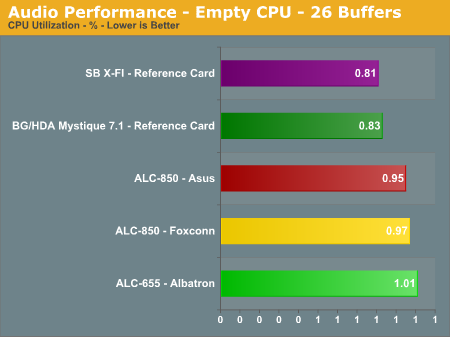
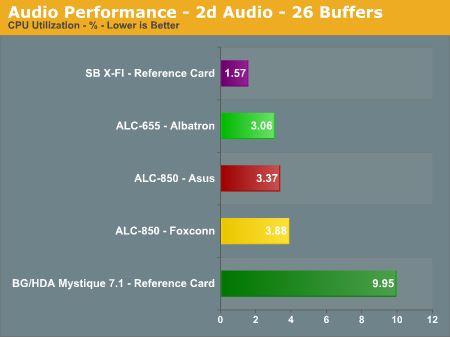
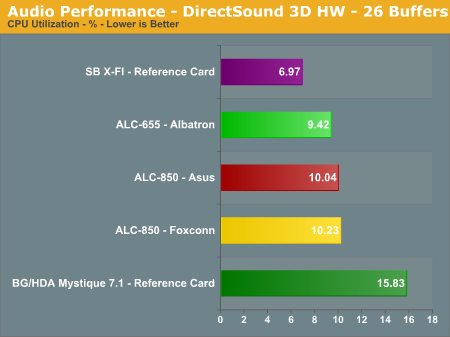
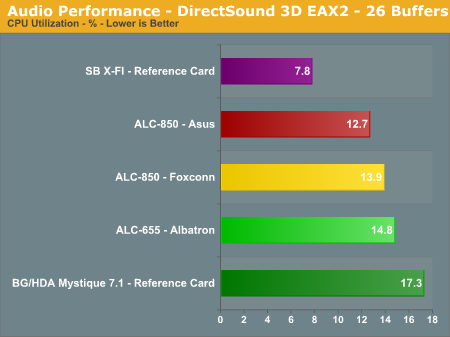
The BlueGears/HDA Mystique 7.1 Gold has the highest utilization rates of the audio solutions tested. BlueGears has confirmed a new driver release within the next 30 days that will offer improved performance in several areas. The RealTek A380 driver release continues to improve CPU utilization rates. The Sound Blaster X-FI has the lowest rates with the Realtek ALC655 solution on the Albatron board following closely. Let's find out how these results translate into real world numbers.
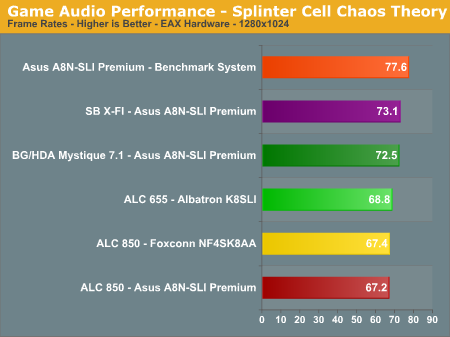


While the Realtek ALC850 and ALC655 codec offer acceptable CPU usage for most office applications or games, it is not competitive in audio quality with the on-board HD audio options on the ATI or Intel boards.










37 Comments
View All Comments
Gary Key - Wednesday, January 4, 2006 - link
As stated in the article the current pricing structure lends itself to the purchase of an SLI capable motherboard if the nForce4 is your chipset of choice. Even if you do not utilize SLI you at least have the option of doing so, if not for gaming, then for multiple monitor support and excellent performance utilizing two x8 lanes. If you look at the current support from the motherboard suppliers and product plans it is very obvious that SLI/CrossFire capable motherboards are becoming the standard across all price points. Our statements were based on these facts regarding the motherboard choices available. If you consider the potential cost/performance benefits then why pay the same amount of money for a board that is not capable of SLI or CrossFire and will probably not receive the same level of support over the lifespan of the product.
bob661 - Wednesday, January 4, 2006 - link
Isn't this a contradiction?
Capt Caveman - Tuesday, January 3, 2006 - link
What are you talking about? You can get a SLI board for $70.andlcool - Tuesday, January 3, 2006 - link
for the asus one, it should be ddr and not ddr2.ElFenix - Tuesday, January 3, 2006 - link
still, should be a good price for stock speed boardsElFenix - Tuesday, January 3, 2006 - link
looking at the first chart i mean. doesn't seem to fall off much eh?<--- wants an edit function
Gary Key - Tuesday, January 3, 2006 - link
The Foxconn board offered excellent stability throughout testing although it certainly is not targeted at the overclocking crowd. The performance was certainly acceptable and without the benchmarks you probably would not be able to tell the difference between it and the other boards. The layout is really nice unless you plan on utilizing two video cards with two slot cooling solutions as the space becomes very tight between the two x16 slots.I would like an edit function also. ;->